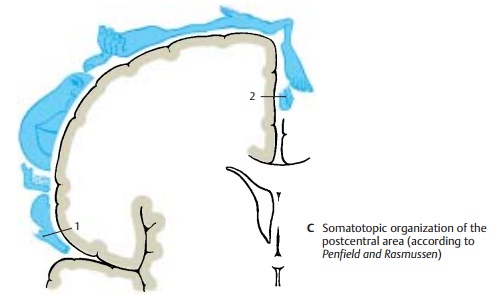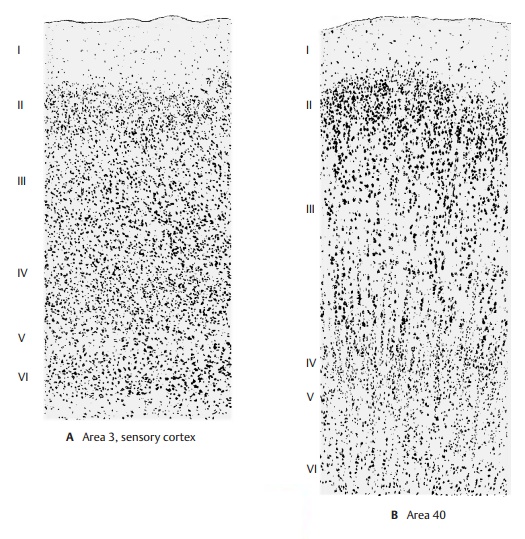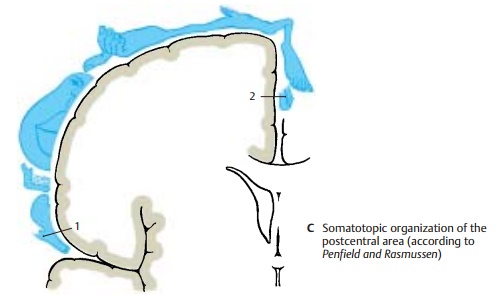Chapter: Human Nervous System and Sensory Organs : Telencephalon
Neocortex: Parietal Lobe

Parietal Lobe
Postcentral Area
The terminal station of the sensory path-ways, the somatosensory cortex, lies on the most anterior convolution of the parietal lobe, the postcentral gyrus. It contains areas 3, 1, and 2. Area 3 lies on the frontal surface of the gyrus and deep in the central sulcus; area 1 covers the top of the gyrus as a nar-row band; and area 2 covers the posterior surface.
In contrast to the motor cortex, the cortex of area 3 (A) is extremely narrow and clearly separated from the white matter. The pyra-midal layers (III and V) are narrower and contain few cells, while the granular layers (II and IV) are much wider. Hence, the cortex of area 3 is part of the koniocortex, orgranu-lar cortex. The cortex of area 40 isshown for comparison (B); it covers the su-pramarginal gyrus and may be regarded asthe prototype of the parietal cortex. Both granular and pyramidal layers are well developed, and the radial striation running through all layers is clearly visible.

The somatosensory cortex receives its affer-ent fibers from the ventral posterior thalamic nucleus in a somatotopic organiza-tion that results in representation of the contralateral body parts in specific cortical areas. The areas for throat and oral cavity lie above the lateral sulcus (C1), and the areas for face, arm, trunk, and leg are superior to it. The leg area reaches beyond the edge of the pallium to the median surface, where the representations of bladder, colon, and genitals (C2) complete the sequence. This creates a sensory homunculus. The cu-taneous regions of highly differentiated sensibilities, such as hand and face, are rep-resented by particularly large cortical areas. The areas for distal parts of the limbs are usually larger than those for proximal parts.
According to clinical and electrophysiologi-cal studies, the superficial skin sensibility is represented by area 3, and the deep sensi-bility by area 2 (predominantly impulsesfrom joint receptors). In area 2, position and movement of the limbs are constantly regis-tered.

Functional Significance of the Parietal Cortex
The function of this area has become known through mental deficiencies following in-jury of the parietal lobe.
Clinical Note: Various types ofagnosiamayoccur. Although sensory impressions are perceived, the importance and characteristics of objects are not recognized. Such disturbances may also affect tactile, optic, or acoustic sensations. There may be disturbances in symbolic thinking when the parietal lobe (angular gyrus) of the dominant hemisphere is affected: the loss of understanding of letters or numbers makes reading and writing, counting and calcu-lating impossible.
Furthermore, disturbances of the body scheme may be observed. They may involve the inability to distinguish between left and right. Also, one’s own paralyzed or nonparalyzed limbs may be sensed as foreign limbs, for example, one’s own arm may be perceived as a heavy iron bar lying on the chest. The disturbance may affect an entire body half, which is then perceived as a different person, “my brother” (hemidepersonalization).
The parietal cortex, which lies between the tactile and the optic cortices and is closely linked to both by fiber connections, is thought to have a special importance for bringing about three-dimensional space perception. Injury to the parietal lobe mayresult in the destruction of this sense.
Related Topics